Splinters of Faith
Splinters of Faith is a campaign series for Pathfinder and Swords & Wizardry published by Frog God Games.
By Gary Schotter and Jeff Harkness
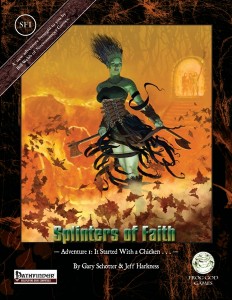
Welcome to the twenty-third Designer’s Diary, a regular column where designers are given the opportunity to take readers on an in-depth ride through the design and development process of their system, setting, or product. If you’d like to share your product in the Designer’s Diary column, send a message to aaron@roleplayerschronicle.com.
DESIGNERS’ DESCRIPTION
Splinters of Faith is a 10-part series published by Frog God Games that was designed with two purposes: Provide an entertaining and dangerous adventure while offering some nontraditional temples for Gamemasters to drop into their campaigns. While it was designed originally as one big book (more on that later), Splinters of Faith was split into 10 separate adventure modules that can be played separately or combined into one big save-the-world campaign that should take 1st-level characters all the way to approximately 14th level. If they make it that far. Playtests were often brutal (more on that later, too). The books are available in two formats: one version for Pathfinder players and another for Swords and Wizardry.
The full adventure takes characters from one temple to the next as PCs restore an ancient artifact called the Scepter of Faiths. This heavy mace with a boatload of special abilities was used to stop the adventure’s villain a long time ago, and was shattered when the bad guy returned from the dead (don’t they always?). Each adventure in the series lets PCs trace the steps of the relic’s creators, seeking blessings at each of the eight temples scattered across the land. Some of the temples stand untouched by the ages, while others have fallen on hard times — or been wiped away completely. It’s up to the PCs to complete the missions in each module to take another step in restoring the artifact.
Map sketch sent to artist for Splinters 7 upper level
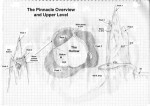
Of course, you don’t have to use the Scepter to run the modules. The adventures are designed to allow GMs to make changes and run the modules without the campaign. The first temple in Splinters of Faith 1: It Started with a Chicken (yep, another one we’ll talk about) is a deadly tomb for first-level characters to explore. The second part, Burning Desires, is a trek through a deadly swamp. Part 3 sends PCs into a flooding sewer, while Part 4 is set atop and beneath a giant pillar of stone supporting a temple of nature-loving, pacifist priests. Five goes into a pyramid abandoned in the desert, six heads to the icy wastelands and inside a glacier, and seven visits a mountain temple. Part 8 delves into a not-so-abandoned mine, while nine climbs into the mountain peaks again for a definitely occupied temple of witches. And ten, oh my, Part 10, goes into the jungle (with some VERY angry T-rexes on the loose!) for the final showdown in a temple of Orcus overrun by the undead. Just hope PCs are smart enough to sneak into that last one, since the denizens there won’t hesitate to smack them down a notch (and steal a few levels, too).

Despite some tough encounters scattered in every module to keep players on their toes, Splinters was designed to get tougher as players get better, which is why we started at first level and built up the difficulty. The first adventure sends PCs into a tomb of the undead, but doesn’t really require any overland travel or wandering monsters that might be too tough. The second drops them into a massive swamp that keeps getting bigger every day thanks to the runoff from some above-ground dwarves’ pesky decanter. From there, you’ll do some city encounters above and below the streets, then go into some environmental adventures to really test PCs before they reach the final adventure. New players should be able to grow into their PCs throughout the campaign.
But don’t think Splinters is a pushover. There are traps and monsters in the series that are best to just run from (if PCs get the chance, heh). There’s a reason we dedicated the series to the 32 PCs who were killed during play testing. In Gary’s game, there were a couple of TPKs that let us know where to tone things back just a little.
PURPOSE
Gary: Splinters of Faith combines the elements of a splat book with the feel of 1st-edition modules. Jeff and I wanted to do a nonspecific campaign book based on temples that could be used in any campaign, sort of like what Necromancer Games had just done with their Book of Taverns. Details of each temple were generic enough to fit into anyone’s home-brew game with minor alterations, a cut-and-paste temple book with some decidedly unexpected locales. We made a list of common religious aspects found in many fantasy worlds (fertility, war, death, etc.) and built unique and usable temples around these concepts. We also wanted to link the temples with a series of short adventures. We’d just come off helping write Glades of Death for Necromancer Games, and this idea of a multi-use book really resonated with us. We wanted Splinters to have a reason for GMs to pick it up, and then a reason to keep them coming back. In Splinters, you get the adventure for the first, and the varied, reusable temples for the second.
INFLUENCES
Gary: Personally, Jeff Harkness has had the most influence on me regarding gaming. Growing up and sharing countless adventures with Jeff (both in game and real world) really inspired my creativity and shaped my personality. Michael Schotter (my uncle) first introduced me to Dungeons & Dragons at the age of 10 and continues to serve as my DM until this day. Of course I have to mention my gaming group (NAGA, New Albany Gaming Association) which has suffered weekly through 17 years of my campaigns.
Of the old school designers, I have to say Frank Mentzer, David “Zeb” Cook and of course Gary Gygax were my favorite writers. T1-4 continues to be the quintessential adventure. I also greatly admire the talents of Roger E. Moore. His tenure at Dragon Magazine includes many of my favorite issues. I have had the privilege of meeting all of them and many more writers and artists through the past 16 years of conventions.
In my opinion, Bill Webb has emerged as one of the greatest influences on the modern game. The man is amazing. His dedication and accomplishments astound me. It is a privilege to be a part of his team. Like many gamers I know, I became pretty unsettled with some of the 4th edition changes. Thanks to Bill Webb, Frog God Games and Paizo Publishing, the adventure continues. Although my current group plays Pathfinder, I found it refreshing to delve into a throwback game of Swords and Wizardry. I started off in the “White Box” Dungeons and Dragons and now I have come full circle. Swords and Wizardry has awakened my enthusiasm for the days of old where the game focused on the players, and the story developed spontaneously around them.
Jeff and I met in middle school in 1983 during the glory days of 1st edition. We started playing D&D at school during any free time possible. While other kids wrote notes about girlfriends, parties or sports; our notes had attack rolls (THAC0), fantasy locations and treasure. I think we journeyed through the entire Sabre River in one semester of study hall. We wrote our first adventure in 1985 titled “The Island of Time.” (Jeff: For “The Island of Time,” think “Dungeonland” and the jokey “Castle Greyhawk” but a lot weirder and with so many jokes and puns that a couple of 15-year-olds think are hilarious and you get the idea what that little endeavor was like!)
We’ve dreamed of having our adventures published ever since.
Jeff: A pair of Garys. And a Bill. And so many more I can’t even remember them all.
Gary Schotter has been a big influence on my writing. I’m more of an editor who loves to write, so I focus on finding the right words, stringing sentences together and making things cohesive throughout. I’m the one going through looking for sidebars to add information to the books, or tightening and editing encounters until they sparkle. But Gary really taught me to look at pop culture, music, movies and the Internet for random items to twist into unique encounters and ideas. Gary has an imagination that knows no bounds, and I’m glad to have had him as a close friend for nearly 30 years.
And, of course, the other Gary. Gygax, I mean. Love his stuff, and meeting him at Gen Con’s past was something special.
Gary mentioned Bill Webb above, and I agree. Thanks to Bill, we were able to publish a 10-book adventure series (20 books if you count the Swords and Wizardry versions) and can now write cool ideas and know they’ll see print. It’s a good feeling when a publisher trusts you. Plus, I have to say that some of the late-night games in the back room at The Ram in Indianapolis after Gen Con were true spectacles with Bill and everyone gathered around the gaming table until the wee hours of the morning.
Sketch sent to artist of small shrine map from Splinters 10 (unused)

RESEARCHING, WRITING AND PLAY TESTING
Gary: For Splinters of Faith, Jeff and I spent a lot of time researching and developing temples that could be modified to meet a home-brew campaign’s needs. We wanted to make the temples close to real world but with strong fantasy elements. For example, Jeff and I researched real-world aspects of Hecate to better describe the Temple of Hecate in Splinters 9: Duel of Magic. Female clergy, triple-bodied sculptures and hounds are all common symbols found in classical temples of Hecate.
Nearly all the names in Splinters of Faith are derived from the real world. For example, Katarrh the white dragon in Splinters 6: Morning of Tears is a German word meaning the inflammation of the mucous membrane. Don’t ask me why I chose that name or why I researched German terminology and inflammations, it was late at night is all I can say. The village of Lessef in Splinters 1: It Started with a Chicken is named after my good friend Dennis Fessel. There are too many obscure references to name them all here.
In all my writings, I make sure that the monsters have a reason for being there. I do not believe in senseless random wandering monsters. Every encounter has a story. While I could not detail each and every gnoll or flind in Splinters 5: Eclipse of the Hearth, I gave the main and supporting characters some background, motivations and depth. The GM is free to use as much or as little of the information provided as he needs. I did not detail, however, exactly how the PCs may discover the information.
The best research possible in writing gaming material is play-testing. I refereed Splinters of Faith twice in my home campaign. Each time, the game play and experience provided new challenges and obstacles that had to be addressed before publication.
Splinters 3: Culvert Operations was ran at Gen Con. When we wrote that chapter, I looked back to old tournament modules from the late 1980s as references. The adventure is very linear for that reason. A GM can research and plan the hell out of an adventure/sourcebook, but the players will always do the unexpected. In one playtest, the key Scepter of Faiths artifact became dis-joined after a mage’s freak disjunction incident. Needless to say, this resulted in a 15th level TPK by the resurrected vampire priest-king and his minions when the PCs finally got to that point later in the campaign.
Jeff: I don’t even think I could go through Splinters and pick out all the names that have some link to the real world; they are just that numerous. Some are even based on real things. Take the Temple of Iseleine in Splinters 4: For Love of Chaos. This slender tower temple with a giant sphere atop it was modeled after the Sunsphere built for the 1982 World’s Fair in Knoxville, Tennessee. I remember seeing it when I was a kid, and it made an impression, obviously. Honestly, I think we could annotate Splinters and it would be filled with footnotes.
One thing I can touch on is the names of each of the modules. Each title was originally the name of the chapter in the combined book (before it was split into its current 10 books). Look closer at each title, and you’ll see plays on words on some of them. One is a play on a familiar phrase (Splinters 3: Culvert Operations), many have dual meanings (The Heir of Sin, Pains of Scalded Glass, Morning of Tears, Duel of Magic) and a couple describe some aspect of the adventure (Burning Desires and For Love of Chaos). But two warrant a little closer inspection:
* Splinters 1: It Started with a Chicken: OK, no real play on words here, but it’s probably the most descriptive title for any adventure published. Why? Because the entire Splinters series starts with PCs trying to find a few lost chickens. Honest. I remember typing those words and Gary and I laughing about it way back then. Little did we know that it would end up gracing the cover and being the kickoff to the series. I still wonder how many people looked at that strange title and passed on buying it, simply because they thought it would be a joke and not the deadly serious adventure it is. (And it was even worse before we pulled a shadow out of the tomb that required magic weapons to hit, which PCs likely wouldn’t have had at 1st level). My favorite find one day was scouring the Internet for mentions of Splinters of Faith after it came out, and finding this adventure on a site that sold chicken-related items. So if you need to buy an egg crate or hen cookie jar with your copy of Splinters 1, I can hook you up.
* Splinters 5: Eclipse of the Hearth: OK. Yes, we knew this was close to the song title. We meant that. But go back and look at the adventure itself, and you’ll find it fits really well. The Hearth (the fallen temple pyramid) and the dirt eclipsing the sun globe atop it, play out through the course of the adventure. (Side note: Not sure where I saw this, but someone talking about this adventure on a messageboard said it should have been named “Toadal Eclipse of the Hearth” since it was published by Frog God Games. I laughed out loud at that one.) And while I’m on Splinters 5, here’s a weird coincidence of real life inserting itself into the adventure. The book contains two versions of the same temple, one from the past and one from the present. The past temple is when the temple was active and flourishing; the present is after its fall into ruin. Same maps, locations, but different descriptions. But there are elements in the past temple that give you an idea why things fell apart. But the coincidence came about by accident. Gary was working on the present temple while I went back and detailed the functioning past version. Gary chose hyenas to populate the upper temple (he was working with an invading gnoll and flind army, after all), while I figured lions would be a great way to celebrate a temple to a sun god. So the lions lived in the temple during its glory days, only to be replaced by the scavenging hyenas after the temple’s fall. Only after the fact did we learn that hyenas and lions are eternal enemies in the real world.
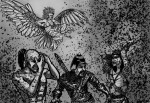
ART DIRECTION
Jeff: Gary and I were really fortunate to work with a couple of great artists on Splinters, although I have to say I caused some headaches with my nitpicking on art pieces — and I know I nearly gave Rick Sardinha, who did the cover and maps, a near heart attack when we first talked. I think the e-mail went something like:
Rick: “I’m doing the 12 maps for Splinters and can’t read this one map note. Can you resend?”
Jeff: “Sure, but 12 maps? I think there are about 50 or so.”
Rick: “How many?!?”*
Sketch sent to artist of Splinters 7 Shield Wall 3D map (unused)
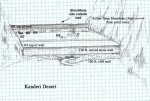
* This is where my memory gets murky. I know Rick didn’t say anything using any four-letter words, but I know he had to be thinking it. Thank goodness he was able to find time to do all those great maps for us once we split Splinters into 10 books with just a couple of maps due each month, instead of that first REALLY big art order. Rick’s been spectacular to work with (and his Christmas cards make you bust a gut and spray milk out of your nose, they’re that funny).
Speaking of Rick: His cover painting for Splinters is amazing. When Gary and I first saw the green-skinned woman wielding dual handaxes on cover, we were absolutely stunned by Rick’s skills. The atmosphere and hint of action in the painting were perfect (and you gotta love the skull on the left side of the woman; hope you spotted it, I know she’s distracting!). But then we realized a small issue: There really wasn’t anything the cover directly matched in any of the books. We’d already turned in most of the early modules in the series, but that wasn’t going to stop us from adding her. And we found a perfect creature already in Splinters 10: Remorse of Life to convert into the woman you see on the cover: Brielle the debased dryad. Gary outfitted her with some very special handaxes and I tweaked the text to make up why there’s a “doorway” in the background trees for PCs to enter through. PCs may never meet her due to the sandbox nature of the adventure, but she’s there and waiting. With those deadly axes.
Char Reed did the interior art for the entire series, working off notes Gary and I put together and tweaked as we progressed, and she did a fabulous job. She was new to the gaming illustration industry, but she took our art suggestions and ran with them. I know some were pretty complex and mixed ideas all over the place (“I need a harpy, flying through a cloud of flies, with fly vortexes curling around her wings. She’s coming down at the PCs, but make sure her torso is covered. We’re going PG, after all.”) but she pulled it all together.
One thing that worked out well, I thought, was the “template” characters we used in the art. We put together a full-page roster of unique characters and their descriptions to serve as anchor points for all of the art throughout the series. Go through the books just looking at the art, and you’ll see the same characters pop up in all the pieces. We wanted it to seem like this group is progressing through the adventure as you are read it. Players would probably never see this little detail, but I hope GMs reading the books noticed.
Gary: To me, art is one of the most important pieces to a successful book. In this game, you can really judge a book by its cover. In my opinion, the art inspires the imagination while the text is merely a guideline for game play. How could anyone not remember the fantastic interior art of Jim Holloway or the dreaded behir cover of The Lost Caverns of Tsojcanth by Erol Otus? Award-winning Rick Sardinha’s fantastic art is among the industry’s best. We are lucky to have him on board. Definitely check out his work (http://www.battleduck.com).
GAMING EXPERIENCE
Gary: We designed Splinters of Faith to be a useful tool for players and referees. Writing a campaign for every game night is taxing and tedious. This book was designed to alleviate some of the burden by providing temples, NPCs and adventure ideas so the GM can focus on the game. We designed the adventure portion to introduce the temples and provide interesting NPCs and encounters. Splinters 1: It Started with a Chicken is a great introductory adventure that could be played in one evening. It seems innocent enough, but could spiral the players into the epic quest. As PCs travel through the different temples, they slowly learn of a resurrected bastion of evil. Although they are not saving the world, the cumulative adventure casts the PCs into a plot to stop perhaps the most powerful priest of Orcus in the history of the material plane, Akruel Rathamon.
Jeff: Have to jump in with another little insight that is probably really, really obvious. Gary designed the vampire-warlord Akruel Rathamon as the series’ villain, and even his name is another play on sounds. Sound it out, and you might hear: A Cruel Wrath of Man. And he is a cruel being, as PCs find out in Splinters 10. But I always thought it interesting that his name is so insightful into his motivations. And I know Gary planned it that way.
Gary: I think it took the first group that played Splinters of Faith as a campaign a little less than a year to complete. That included about 4 hours of play each week with a large group. We have eight regular players and a GM every week, so it took awhile to play through the adventures.
COMPARISON
Gary: The book has dual purposes, so comparisons to other products are not easy. I would not even begin to compare this series to the classic modules but they were certainly major influences on its development. The series combines the elements of Necromancer Games’ Book of Taverns with an adventure series. I think Splinters of Faith fits well with the current trend of adventure paths but it is more than that.
Artist Rick Sardinha’s final map used in Splinters 9
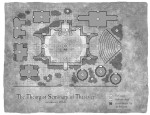
It was written and designed to be self-contained but also to fit into other campaigns with minor tweaking. For example, the island city of Jah Sezar in Splinters 9: Duel of Magic could be placed in any major body of water. The description reads “Sitting atop the central peak is the city’s most famous landmark: The Theurgist Seminary of Thasizier. The temple’s dome lights each night, casting a warm glow over the city below. The temple’s light can be seen for many miles out to sea, and acts as a beacon to passing ships.” The details of the city are intentionally left for the GM and players to flesh out. The seminary, on the other hand, has detailed maps and NPCs. These characteristics are a direct influence from the Wilderlands of High Fantasy.
DEVELOPMENT PROCESS
Jeff: Splinters had a long, long birth before Gamemasters got their hands on it and gamers got to dive into it. In fact, Gary and I put the first sentences to paper somewhere around 2003 shortly after D&D 3.5 was released. Yep, you heard that right, 3.5. The entire Splinters adventure (written as one big book at this point) was written using the 3.5 rules. We turned it in to Bill Webb and Clark Peterson at Necromancer Games and were just glad to be done with it. It had consumed a year or so of our lives getting it all together.
Then something unexpected happened as we waited for it to be published: Fourth Edition was released in 2007.
And Gary and I realized that for Splinters to see the light of day, it would have to be converted. So then came the reading of the new 4th edition rules, with an eye toward what we’d need to do to convert it if Bill and Clark decided to print under the new rules. But as we read the rules and played 4th Edition, Gary and I had this nagging feeling that Splinters just couldn’t survive under the new rules — not as it was, that is. The way encounters were designed in the series was simply too different and wouldn’t have worked well under the revised rules. Splinters would have had to be completely overhauled to go out under 4th edition rules, and you have to remember that this was before anyone knew if you could even publish under the new rules.
So we waited, and Splinters fell onto the back burner.
And then a funny thing happened: Pathfinder hit its stride with a rules system not too different from 3.5. Gary and I knew we could convert Splinters to Pathfinder if it came down to it. We just needed a company to publish it.
That’s where Bill Webb came through for us, starting Frog God Games right about then and focusing on publishing adventures using the Pathfinder rules. Splinters of Faith had been touted for years on the Necromancer Games website by this point, and was considered one of the “lost” Necromancer products. If you bought any Necromancer Games’ adventures, I think Splinters was originally supposed to be K11 in a series that included The Coils of Set, The Mother of All Encounter Tables, and Demonheart). Bill was eager to publish these books, which is how Splinters not only changed editions, but jumped companies (sort of).
When Bill gave us the green light, Gary set about converting the monsters to Pathfinder stats (this was before Frog God Games’ Tome of Horrors Complete was even a gleam in anyone’s eye) and we started working on converting the behemoth that was Splinters into the new rules.
Then something else unexpected happened: Bill teamed up with Matthew Finch to put out the Swords and Wizardry Handbook. Bill told Gary and me about this before the public announcement, and asked if we’d also be able to stat Splinters out and convert it to Swords and Wizardry to publish a Pathfinder AND a Swords and Wizardry version of each book at the same time. Now, Gary and I grew up playing the old-school modules, so this “new” rules set was really what we’d cut our gaming teeth on. Sure, there were some changes, but for the most part they were rules we knew. So Gary was hard at work on the Pathfinder version, while I immediately jumped into the Swords and Wizardry changes.
Splinters was very much on the front burner by this point. And, follow along now, made the jump from 3.5 to almost 4th edition to Pathfinder to Swords and Wizardry! We joked about it going from the technical end of the spectrum with 3.5 and Pathfinder to the rules-light, imagination-heavy 0E.
All in all, Splinters has been a fun ride, and we still get to experience it again every so often when new people discover the books. It’s hard to imagine the length of time it took to get this book out the door to gamers, but it was worth it. Sure, we made some missteps along the way (and believe me, we read every rave and criticism of the books with a sharp eye as to what we can change in the future).
And just because Splinters ended, don’t think we won’t be going back to it. The n’gathau adventure series we’re working on now for Frog God Games uses some of the same locales (set now and … sometime else … although I can’t say much more than that). And if you’re really interested, read through those lairs from the Tome of Horrors Complete I mentioned earlier. You’ll find places like the Wailing Glacier, the Hollow Spire Mountains, the Seething Jungle and more drawn straight out of Splinters and made part of Frog God Game’s great, great monster book. (You may even find some surprises we hid in there about that n’gathau adventure!). Plus, there’s even a “lost” module that didn’t really fit into the series, but that still follows the Splinters convention of two temples connected by an adventure. Gary and I have talked publishing it someday, maybe as a free adventure, or perhaps as a way to revisit Splinters sometime in the future.
So that’s it. Some ramble, some information, and a whole lot of fun for us — and I hope for you, too. Thanks especially to everyone who picked up Splinters of Faith, thanks to Bill Webb from Frog God Games for making it a reality, and to all the people who brought the books to you (Chuck Wright for the layouts, Rick Sardinha for the cover and maps, and Char Reed for the art), and Matthew Finch for the wonderful Swords and Wizardry rules.
Gary: Many years ago Monte Cook signed one of his adventures (Return to the Temple of Elemental Evil) with “Apologize to your players for me.” I think this quote applies to any great prewritten adventure. I hope you’ll agree that Splinters of Faith fits this bill.
Want the whole series? Check out Frog God Games’ website at www.talesofthefroggod.com where you can buy the entire series listed below and many other great adventures:
Books in the Splinters of Faith series:
- It Started with a Chicken
- Burning Desires
- Culvert Operations
- For Love of Chaos
- Eclipse of the Hearth
- Morning of Tears
- The Heir of Sin
- Pains of Scalded Glass
- Duel of Magic
- Remorse of Life



